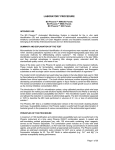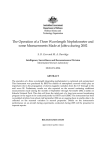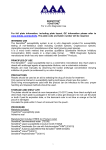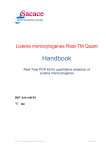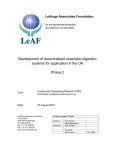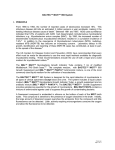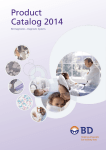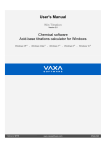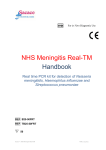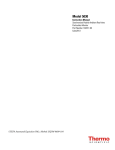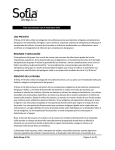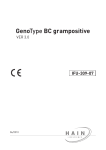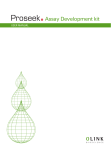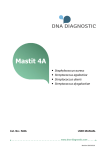Download LABORATORY PROCEDURE
Transcript
LABORATORY PROCEDURE BD Phoenix™ SMIC/ID Panels BD Phoenix™ SMIC Panels INTENDED USE The BD Phoenix™ Automated Microbiology System is intended for the in vitro rapid identification (ID) of bacteria from pure culture belonging to the genera Streptococcus. The BD Phoenix Automated Microbiology System is also intended for the quantitative determination of antimicrobial susceptibility by minimal inhibitory concentration (MIC) of Gram Positive bacteria from pure culture belonging to the genera Streptococcus. SUMMARY AND EXPLANATION OF THE TEST Micromethods for the biochemical identification of microorganisms were reported as early as 19181. Several publications reported on the use of the reagent-impregnated paper discs and micro-tube methods for differentiating enteric bacteria1-9. The interest in miniaturized identification systems led to the introduction of several commercial systems in the late 1960s, and they provided advantages in requiring little storage space, extended shelf life, standardized quality control, and ease of use. Many of the tests used in the Phoenix ID panels are modifications of the classical methods. These include tests for fermentation, oxidation, degradation and hydrolysis of various substrates. In addition to these, the Phoenix system utilizes chromogenic and fluorogenic substrates as well as single carbon source substrates in the identification of organisms10,11. The modern broth microdilution test used today has origins in the tube dilution test used in 1942 by Rammelkamp and Maxon to determine in vitro antimicrobial susceptibility testing of bacterial isolates from clinical specimens12. The broth dilution technique involves exposing bacteria to decreasing concentrations of antimicrobial agents in liquid media by serial two-fold dilutions. The lowest concentration of an antimicrobial agent in which no visible growth occurs is defined as the minimal inhibitory concentration (MIC). The introduction in 1956 of a microtitrator system, using calibrated precision spiral wire loops and droppers for making accurate dilutions rapidly allowed Marymont and Wentz to develop a serial dilution antimicrobial susceptibility test (AST)13. The microtitrator system was accurate and allowed the reduction in volumes of antimicrobial agents. The term microdilution appeared in 1970 to describe the MIC tests performed in volumes of 0.1 mL or less of antimicrobial solution14. The Phoenix AST test is a modified miniaturized version of the micro-broth doubling dilution technique. Susceptibility testing in the Phoenix system is performed through determination of bacterial growth in the presence of various concentrations of the antimicrobial agent tested. PRINCIPLES OF THE PROCEDURE A maximum of 100 identification and antimicrobial susceptibility tests can be performed in the Phoenix instrument at a time using Phoenix ID/AST combination panels. A sealed and self-inoculating molded polystyrene tray, with 136 micro-wells containing dried reagents, serves as the Phoenix disposable. The combination panel includes an ID side with dried substrates for bacterial identification, an AST side with varying concentrations of antimicrobial agents, and growth and fluorescent controls at appropriate well locations. The Phoenix system utilizes an optimized colorimetric redox indicator for AST, and a variety of colorimetric and fluorometric indicators for ID. The AST Broth is cation-adjusted (e.g., Ca++ and Mg++) to optimize susceptibility testing performance. Page 1 of 16 The Phoenix panel is comprised of a 51 well ID side and an 85 well AST side. The ID side contains 45 wells with dried biochemical substrates and 2 fluorescent control wells. The AST side contains 84 wells with dried antimicrobial agents and 1 growth control well. Panels are available as ID only (Phoenix™ NID Panels, Phoenix™ PID Panels), AST only (Phoenix™ NMIC Panels, Phoenix™ PMIC Panels, Phoenix™ SMIC Panels), or ID/AST combination (Phoenix™ NMIC/ID Panels, Phoenix™ PMIC/ID Panels, Phoenix™ SMIC/ID panels). Unused wells are reserved for future use. Phoenix panels are inoculated with a targeted organism density of 0.5 McFarland (0.5 to 0.6 McFarland is acceptable). Organism suspensions must be prepared only with the BBL™ CrystalSpec™ or BD PhoenixSpec™ Nephelometer. Once inoculated, panels are placed into the instrument and continuously incubated at 35°C. The instrument tests panels every 20 minutes: on the hour; at 20 minutes past the hour; and again at 40 minutes past the hour for up to 16 hours if necessary. Phoenix panels are read only by the instrument. Phoenix panels cannot be read manually. Bacterial Identification: The ID portion of the Phoenix panel utilizes a series of conventional, chromogenic, and fluorogenic biochemical tests to determine the identification of the organism. Both growth-based and enzymatic substrates are employed to cover the different types of reactivity in the range of taxa. The tests are based on microbial utilization and degradation of specific substrates detected by various indicator systems. Acid production is indicated by a change in the phenol red indicator when an isolate is able to utilize a carbohydrate substrate. Chromogenic substrates produce a yellow color upon enzymatic hydrolysis of either p-nitrophenyl or p-nitroanilide compounds. Enzymatic hydrolysis of fluorogenic substrates results in the release of a fluorescent coumarin derivative. Organisms that utilize a specific carbon source reduce the resazurin-based indicator. In addition, there are other tests that detect the ability of an organism to hydrolyze, degrade, reduce, or otherwise utilize a substrate. A complete list of taxa that comprises the Phoenix ID Database is provided in Table A. Reactions employed by various substrates and the principles employed in the Phoenix ID reactions are described in Table B. Antimicrobial Susceptibility Testing: The Phoenix AST method is a broth based microdilution test. The Phoenix system utilizes a redox indicator for the detection of organism growth in the presence of an antimicrobial agent15. Continuous measurements of changes to the indicator as well as bacterial turbidity are used in the determination of bacterial growth. Each AST panel configuration contains several antimicrobial agents with a range of two-fold doubling dilution concentrations. Organism identification is used in the interpretation of the MIC values of each antimicrobial agent producing Susceptible, Intermediate or Resistant (SIR) result classifications. A complete list of taxa for which the Phoenix system can provide AST results is provided in Table A. The list of antimicrobial agents and concentrations available for susceptibility testing in the Phoenix system is provided under Performance Characteristics. There are antimicrobial agents for use with the Phoenix System that are not proven to be effective for treating infections for all organisms listed in the taxa. For interpreting and reporting results of antimicrobial agents that have been shown to be active against organism groups both in vitro and in clinical infections refer to the individual pharmaceutical antimicrobial agent labeling. Alternatively, refer to the most recent CLSI M100 Performance Standard, Table 1 “Suggested Groupings of US FDA-Approved Antimicrobial Agents That Should Be Considered for Routine Testing and Reporting on Organisms by Clinical Microbiological Laboratories”16. The components required for testing using the Phoenix system for streptococci include: 1) Phoenix panels with panel closures, 2) Phoenix ID Broth, 3) Phoenix AST-S Broth, 4) Phoenix AST-S Indicator solution 5) Phoenix Inoculation Station, 6) Phoenix Panel Caddy, 7) BBL CrystalSpec™ or BD PhoenixSpec™ Nephelometer, 8) 25 µL pipettor and sterile tips, and 9) Miscellaneous lab supplies (listed under Materials Required But Not Provided). Page 2 of 16 Prior to inoculation, the Phoenix panel is placed on the Inoculation Station with the inoculation ports at the top for filling. Separate inocula are added manually to the ID and AST ports. The inocula flow down the panel in serpentine fashion, filling the panel wells as the liquid front progresses toward the pad. The pad absorbs excess inoculum. Closures are manually inserted in the fill ports. An air admittance port is located in the divider area of the panel lid to ensure adequate oxygen tension in the panel for the duration of the test. INGREDIENTS: For a listing of biochemical substrates used in the Phoenix panel refer to Table B. The package insert enclosed in the panel box provides a listing of the specific antimicrobial agents and concentrations found in the panel. PRECAUTIONS For in vitro Diagnostic Use All patient specimens and microbial cultures are potentially infectious and should be treated with universal precautions. Please refer to CDC manual Bio-safety in Microbiological and Biomedical Laboratories, 4th Edition, 1999, as well as other recommended literature. Prior to discarding, sterilize specimen containers and other contaminated materials by autoclaving. Panels, once inoculated, should be handled carefully until placed in the instrument. STORAGE AND HANDLING Phoenix Panels: Panels are individually packaged and must be stored unopened at room temperature (15 - 25°C). Do not refrigerate or freeze. Visually inspect the package for holes or cracks in the foil package. Do not use if the panel or packaging appears to be damaged. If stored as recommended, the panels will retain expected reactivity until the date of expiration. Phoenix ID Broth: Tubes are packaged as 100 tube packs. Visually inspect the tubes for cracks, leaks, etc. Do not use if there appears to be a leak, tube or cap damage or visual evidence of contamination (i.e., haziness, turbidity). Store Phoenix ID Broth tubes at 2-25°C. Expiration dating is shown on the tube label. Phoenix AST-S Broth: Tubes are packaged as 100 tube packs. Visually inspect the tubes for cracks, leaks, etc. Do not use if there appears to be a leak, tube or cap damage or visual evidence of contamination (i.e., haziness, turbidity). Store Phoenix AST-S Broth tubes at 2-25°C. Expiration dating is shown on the tube label. Phoenix AST-S Indicator Solution: The indicator solution is individually pouched and packaged as a package of 10 dropper bottles. Visually inspect the bottle for cracks, leaks, etc. Do not use if there appears to be a leak, bottle or cap damage or any change from a dark blue color. Store Phoenix AST-S Indicator Solution at 2-8°C. Each bottle contains enough solution to test up to 100 panels. Expiration dating is shown on the box, pouch, and bottle label and is for unopened bottles. An opened bottle is stable for up to 14 days if stored at 2-8°C. Be sure the bottle is held vertically when dispensing the AST Indicator Solution. SPECIMEN COLLECTION AND PROCESSING The Phoenix system is not for use directly with clinical specimens. Only pure culture isolates of streptococci are acceptable for testing. The test isolate must be a pure culture. It is recommended that cultures be no more than 24 hours old unless additional incubation is required to achieve sufficient growth. Page 3 of 16 Isolates must be tested with a Gram stain test to assure the appropriate selection of Phoenix panel type. Once the Gram stain reaction is confirmed, select the appropriate Phoenix panel for inoculation (e.g., SMIC/ID panel for use with Gram Positive organisms demonstrating strep-like morphology). Selection of the incorrect panel type could lead to incorrect results. For AST testing in the Phoenix system, isolates recovered from non-selective media are recommended. It is recommended that media containing antibiotics not be used for organisms to be tested in the Phoenix system. Selective media may inhibit some strains of bacteria; therefore, caution must be used when selecting isolated colonies from these media. For ID and AST testing, refer to Table C for recommended media. When swabs are used, only cotton-tipped applicators should be used to prepare the inoculum suspensions. Some polyester swabs may cause problems with inoculation of the panels. The usefulness of the Phoenix system or any other diagnostic procedure performed on clinical specimens is directly influenced by the quality of the specimens themselves. It is strongly recommended that laboratories employ methods discussed in the Manual of Clinical Microbiology17 for specimen collection, transport, and placement on primary isolation media. Inoculum for use on the Phoenix system is prepared by the CLSI recommended direct colony suspension method18. Due to variations in inoculum concentrations prepared with McFarland standards, use of the BBL CrystalSpec or BD PhoenixSpec nephelometer is required for adjusting the test inoculum prior to use in the Phoenix system. It is highly recommended that the purity of the ID or AST inoculum be checked by preparing a purity plate. See “Purity Check” below. MATERIALS REQUIRED: Materials Provided: · Phoenix Panels · Phoenix ID Broth · Phoenix AST-S Broth · Phoenix AST-S Indicator Solution · Phoenix Inoculation Station · Phoenix Transport Caddy · BBL™ CrystalSpec™ or BD PhoenixSpec™ Nephelometer · 25 µL pipettor and sterile tips · 2 Pipette stands Materials Required But Not Provided: · Gram stain reagents · Sterile cotton swabs · Nonselective culture plated media (e.g., Trypticase™ Soy Agar with 5% Sheep Blood) · Incubators · Biohazard disposable container Page 4 of 16 · Markers, etc PHOENIX TEST PROCEDURE Note: The Phoenix instrument should always be powered on. If it is not, power on the instrument and allow 2 hours for the instrument to warm up before loading panels. Prepare the Phoenix instrument to receive new panels as described in the BD Phoenix System User’s Manual (“Operation, Daily System Maintenance”). Care should be exercised when handling Phoenix panels. You should handle panels by the sides only to avoid marking, smudging or obscuring the front or back of the panel in any way. Accession barcode labels affixed to a Phoenix panel should: · Not be of fluorescent material · Not cover any Phoenix panel reaction wells · Not cover the Phoenix panel sequence number barcode Phoenix Strep Panels Phoenix Strep panels are for the identification and antimicrobial susceptibility testing of most Streptococcus species. Although Streptococcus species may be identified in the Gram Positive panels, antimicrobial susceptibility cannot be reported when using these panels. The Phoenix Strep panels, which must be used with Phoenix™ AST-S Broth and Phoenix™ AST-S Indicator Solution, provide the conditions required for rapid AST testing of most Streptococcus species. These reagents are not interchangeable with the AST Broth and AST Indicator Solution that are used with Phoenix Gram Positive and Gram Negative panels. Broth and Panel Preparation: 1. Confirm the Gram stain reaction of the isolate before proceeding with the inoculum preparation for use in the Phoenix instrument. Once the Gram stain reaction is confirmed, select the appropriate Phoenix panel for inoculation. Selection of the incorrect panel type could led to incorrect results. 2. Examine the pouch, and do not use the panel if the pouch is punctured or opened. Remove the panel from the pouch. Discard the desiccant. Do not use the panel if there is no desiccant or if the desiccant pouch is torn. Note: Panels must be used within 2 hours of being removed from the pouch. 3. Place the panel on the Inoculation Station with ports at the top and pad on the bottom. 4. Label a Phoenix ID Broth tube with the patient’s specimen number. Using aseptic technique, select well isolated colonies of similar morphology that are 18-24 hours old with the tip of a sterile cotton swab (do not use a polyester swab) or a wooden applicator stick from one of the recommended media. See Table C. 5. Suspend the colonies in the Phoenix ID Broth (4.5mL). 6. Cap the tube and vortex for 5 seconds. 7. Allow approximately ten seconds for air bubbles to surface. Tap the tube gently to aid in eliminating bubbles. 8. Insert the tube into the BBL CrystalSpec or BD Phoenix Spec Nephelometer. Make sure the tube is inserted as far as it will go. (Refer to the BBL CrystalSpec Nephelometer or BD PhoenixSpec product insert for correct usage instructions and calibration verification.) Page 5 of 16 9. A range of 0.50-0.60 is acceptable when using the PhoenixSpec and a range of 0.5-0.6 is acceptable when using the CrystalSpec. If the density of organisms is low, you can add colonies from the isolate. Re-vortex the sample and reread to confirm that the correct density has been achieved. If the density of organisms exceeds 0.6 McFarland, follow the steps below to dilute the broth. It is very important to accurately fill the wells in the panel. Note: The standardized bacterial suspension in ID broth must be used within 60 minutes of preparation. a Using a marker, mark the broth level in the over-inoculated Phoenix ID Broth tube. b Using a sterile pipette, aseptically add fresh Phoenix ID Broth to the inoculum. Only Phoenix ID Broth may be used to dilute the inoculum. c Vortex the tube and allow to sit for 10 seconds. d Place the tube in the nephelometer and remeasure the turbidity of the suspension. • If the reading is greater than 0.6, repeat Steps b-d. • If the reading is 0.5, go to Step e. e Using a sterile pipette, aseptically remove excess broth to the original level indicated by the mark on the tube created in Step a. Remove excess broth to avoid overfilling the panel. Also, do not remove too much broth, as there may be insufficient broth to adequately fill the panel. f Broth may now be used to inoculate the Phoenix AST Broth and/or the Phoenix Panel. 10. If you are performing identification only, proceed to Step 15 and continue the procedure. 11. Add one free-falling drop of the Phoenix AST-S indicator to each AST-S broth tube. Invert to mix. DO NOT VORTEX. Note: AST-S Broth and AST-S Indicator Solution are for use with the Phoenix Strep panels (SMIC/ID, SMIC) only. These reagents are not interchangeable with the AST Broth and AST Indicator Solution used with Phoenix Gram Positive and Gram Negative panels. Allow AST-S Indicator Solution to warm to room temperature before dispensing into AST-S broth. The unused portion of the indicator should be returned to 2- 8ºC as soon as possible. Do not store at room temperature for more than 2 hours. Opened bottles should be discarded after 14 days from initial opening. If volume other than one drop is added inadvertently, discard the tube and use a fresh tube of AST-S broth. After the addition of the Indicator to AST-S broth, the mixed solution can be stored in the dark, at room temperature, for as long as 8 hours. Tubes must be used within 2 hours after the addition of the indicator solution if exposed to light. 12. Using a pipettor, transfer 25 µL of the standardized bacterial suspension from the ID tube into the AST-S broth tube. Note: Panels must be inoculated within 30 minutes of the time that the AST-S Broth inoculum is prepared. 13. Cap the AST-S tube and invert several times to mix. Do not vortex. 14. Wait a few seconds for air bubbles to surface. Tap the tube gently to aid in eliminating bubbles. 15. Pour the ID tube inoculum into the fill port on the ID side of the panel (51-well side). Allow the fluid to traverse down the tracks before moving the panel. If using an AST (only) panel, DO NOT inoculate the ID side of the panel. Retain the ID or AST-S tube for an optional purity check (see below.) Page 6 of 16 16. Pour the AST-S tube inoculum into the fill port on the AST side of the panel (85-well side). Allow the fluid to traverse down the tracks before moving the panel. 17. Before placing panel closure, check for residual droplets of inoculum on the edge of the fill ports. If a droplet is present, remove the droplet with absorbent material. The used absorbent material must be discarded along with your biohazard waste. 18. Snap on the panel closure. Make sure that the closure is fully seated. 19. Visually inspect panels to be sure each of the wells is full. Look at both sides of the panel. Make certain that the wells are not overfilled. If any of the wells are unfilled or overfilled, inoculate a new panel. Note: Panels must be loaded into the instrument within 30 minutes of inoculation. Panels must be kept in the inoculation station after inoculation until the excess fluid has been completely absorbed by the pad. Panels should stay vertical in the transport caddy until loaded into the instrument. Inoculated panels should be handled with care. Avoid knocking or jarring the panel. Purity Check 1. Using a sterile loop, recover a small drop from the inoculum fluid either before or after inoculating the panel. 2. Inoculate an agar plate (any appropriate medium) for a purity check. 3. Discard inoculum fluid tube and cap in a biohazard disposal container. 4. Incubate the plate for 24-48 hours at 35°C under appropriate conditions. For instructions for panel login and loading, refer to the BD Phoenix System User’s Manual (“Panel Login” and “Inserting Panels in Instrument”). USER QUALITY CONTROL In order to ensure appropriate set up procedure and acceptable performance of the system, the following organisms are recommended to be tested. The user is advised to review the individual AST panel formats to determine if all test strains need to be tested for routine laboratory Quality Control. Refer to the Package Insert that accompanies the Phoenix panels for expected ID results and AST results for QC organisms. For instructions for QC panel login and loading, refer to the BD Phoenix System User’s Manual (“Panel Login” and “Inserting Panels in Instrument”). SMIC/ID panels: Streptococcus pneumoniae ATCC™ 49619 Streptococcus agalactiae ATCC™ 13813 SMIC panels: Streptococcus pneumoniae ATCC™ 49619 For the most reliable results, it is recommended that the QC organisms be subcultured at least twice on two consecutive days onto TSA II with 5% Sheep Blood Agar before use in the Phoenix system. Compare recorded results to those listed in the Package Insert. If discrepant results are obtained, review test procedures as well as confirm purity of the quality control strain used before contacting BD Diagnostics Technical Services Department. Unacceptable QC results Page 7 of 16 are documented as “Fail” and acceptable QC results are documented as “Pass” on the QC Report. RESULTS Organism identification will appear on the Phoenix Report Form with a probability percentage from the Phoenix database based on the substrate reaction profile. Results from each substrate will appear as +, -, V, or X for each reaction. The MIC results will be shown for all antimicrobial agents, and Interpretive Categorical Results (SIR) will be shown for the appropriate organism/antimicrobial agent combinations. Special messages will be shown when the BDXpert System detects results that are of particular clinical interest. Further information concerning results obtained from the Phoenix system can be found in the BD Phoenix System User’s Manual (“Obtaining Results”). Messages Error messages may appear if the system detects unexpected reactivity due to inappropriate procedure or instrument malfunction. For a complete listing of error codes and their meaning refer to the BD Phoenix System User’s Manual (“System Alerts,” “Needs Attention” and “Troubleshooting”). Special Notes In general, the Phoenix System provides a MIC for all organisms at any of the concentrations defined on a specific panel. For certain antimicrobic/organism combinations a specific minimum or maximum MIC is reported even if there is a lower or higher concentration on the panel. These MIC values are applied by the software and are reported out as less than or equal to (</=) for the minimum MIC or greater than (>) for the maximum MIC. The table below provides the range for these special antimicrobic/organism combinations. Antimicrobial Agent Penicillin Organism(s) Applied Range (µg/mL) Streptococcus agalactiae 0.0313-8 Streptococcus viridans group 0.0313-8 LIMITATIONS OF THE PROCEDURE See the package insert shipped with the panel for specific organism/antimicrobial limitations. General A Gram stain test is required for the selection of the appropriate Phoenix panel types. Accurate identification and/or AST results may not be made without this test. Use only well-isolated bacterial colonies from one of the recommended primary isolation media. See Table C. Use of mixed colonies could result in inaccurate identification and/or AST interpretations. A suspension equivalent of 0.5-0.6 McFarland standard must be met and prepared only with the BBL CrystalSpec or BD PhoenixSpec Nephelometer. Use of alternate methods for suspension preparation may cause erroneous identification and/or AST results. Phoenix panels can be read only by the Phoenix instrument. Visual interpretation of the Phoenix panels is not possible. Any attempt to manually interpret results from the panel may Page 8 of 16 lead to misidentification and/or inaccurate AST interpretations. Identification The unique panel environment combined with the shortened incubation time may result in Phoenix panel reactions varying from those obtained using conventional biochemical media. Antimicrobial Susceptibility Testing After the addition of the Phoenix AST-S Indicator Solution to the AST-S broth tubes, mix by inversion. DO NOT VORTEX. Vortexing may cause air bubbles to form in the AST-S broth, which can result in inappropriate filling of the Phoenix panel during inoculation. Because of the low probability of occurrence or special growth requirements, some organisms included in the ID taxa are not included in the AST database. These organisms will display the message “Organism not included in the AST database, perform alternate method.” For some organism/antimicrobial combinations, the absence of resistant strains precludes defining any result categories other than “susceptible.” For strains yielding results suggestive of a “nonsusceptible” category, organism identification and antimicrobial susceptibility test results should be confirmed. Subsequently, the isolates should be saved and submitted to a reference laboratory that will confirm the result using the CLSI reference dilution method. PERFORMANCE CHARACTERISTICS Identification of Streptococcus species (SMIC/ID) In an internal study, the performance of the Phoenix for identification of Streptococcus species was evaluated. Results from 655 isolates were evaluated against commercial and non-commercial methods. The Phoenix streptococci identification performance is outlined below: Agreement Genus/Species Level 96.3% No Agreement 2.4% No ID 1.2% An internal study was performed to simulate inter-site reproducibility. The identification results obtained using the Phoenix system were compared with expected results. This performance testing demonstrated intra-site and inter-site reproducibility of at least 95% or greater. Gram Positive Susceptibility Clinical, stock, and challenge isolates were tested across multiple clinical sites to determine Essential Agreement (EA) and Category Agreement (CA) of the Phoenix system to the CLSI Broth Microdilution reference method with lysed horse blood. Essential Agreement occurs when the MIC of the Phoenix system and the reference method agree exactly or is within ± 1 dilution of each other. Category Agreement occurs when the Phoenix system results agree with the reference method with respect to the CLSI categorical interpretative criteria (susceptible, intermediate, resistant). The table below summarizes the data from these studies. Additionally, testing performed at multiple clinical sites demonstrated at least 95% reproducibility or greater within ± 1 doubling dilution for all antimicrobial agents listed in the table below. Page 9 of 16 DRUG CLASS DRUG NAME DRUG CODE DRUG RANGE) EA N EA % CA N CA % (µg/mL 5-Fluoroquinolone Gatifloxacin GAT 0.625-8 1939 95.0 1939 99.1 5-Fluoroquinolone Levofloxacin LVX 0.25-16 1955 97.6 1955 99.3 B-Lactam Pen. Amoxicillin AMX 0.0313-32 1932 96.8 1932 97.0 B-Lactam Pen. Penicillin P 0.0156-32 1941 96.6 1941 94.7 Carbapenem Meropenem MEM 0.0313-2 1558 97.0 1558 99.4 Cephem Cefepime FEP 0.0625-4 1890 97.7 1890 94.3 Cephem Cefotaxime CTX 0.0625-4 2009 97.8 2009 97.4 Cephem Ceftriaxone CRO 0.0625-4 2013 98.3 2013 97.0 Cephem Cefuroxime CXM 0.125-4 1938 97.2 915 97.3 Folate Antagonist Trimethoprim/ 16/304 906 95.8 906 95.3 sulfamethoxazole 0.0625/1.1875SXT Glycopeptide Vancomycin VA 0.0625-32 1939 98.2 1939 99.8 Macrolide Erythromycin E 0.0156-4 1593 94.4 1593 98.1 Lincosamide Clindamycin CC 0.0313-4 1942 94.3 1942 97.3 Oxazolidinone Linezolid* LZD 0.25-16 1934 96.9 1934 98.6 Tetracycline Tetracycline 0.0625-16 1568 95.2 1568 97.8 TE * The ability of the system to detect resistance for this drug with Streptococcus species is unknown because a sufficient number of resistant organisms were not available at the time of comparative clinical testing. REFERENCES 1. Bronfenbrenner, J., and Schlesigner, M.J. 1918. “A Rapid Method for the Identification of Bacteria Fermenting Carbohydrates,” Am. J. Public Health. 8:922-923. 2. Arnold, W.M., Jr., and Weaver, R.H. 1948. “Quick Microtechniques for Identification of Cultures - I. Indole production,” J. Lab. Clin. Med. 33:1334-1337. 3. Bachmann, B., and Weaver, R.H. 1951. “Rapid Microtechnics for Identification of Cultures - V. Reduction of Nitrates to Nitrites,” Am. J. Clin. Pathol. 21:195-196. 4. Hannan, J., and Weaver, R.H. 1948. “Quick Microtechniques for the Identification of Cultures - II. Fermentations,” J. Lab. Clin. Med. 33:1338-1341. 5. Hartman, P.A. 1968. Paper strip and disc methods, p. 123-132. Miniaturized microbiological methods. Academic Press, New York. 6. Sanders, A.C., Faber, J.E., and Cook, T.M. 1957. “A Rapid Method for the Characterization of Enteric Pathogen Using Paper Discs,” Appl. Microbiol. 5:36-40. 7. Synder, M.L. 1954. “Paper Discs Containing Entire Culture Medium for the Differentiation of Bacteria,” Pathol. Bacteriol. 67:217-226. 8. Soto, O.B. 1949. “Fermentation Reactions with Dried Paper Discs Containing Page 10 of 16 Carbohydrate and Indicator,” Puerto Rican J. Publ. Hlth. Trop. Med. 25:96-100. 9. Weaver, R.H. 1954. “Quicker Bacteriological Results,” Am. J. Med. Technol. 20:14-26. 10. Kämpfer, P., Rauhoff, O., and Dott, W. 1991. “Glycosidase Profiles of Members of the Family Enterobacteriaceae,” J. Clin. Microbiol. 29:2877-2879. 11. Manafi, M., Kneifel, W., and Bascomb, S. 1991. “Fluorogenic and Chromogenic Substrates Used in Bacterial Diagnostics,” Microbiol. Rev. 55:335-348. 12. Rammelkamp, C.H. and Maxon, T. 1942. “Resistance of Staphylococcus aureus to the Action of Penicillin,” Proc. Soc. Biol. and Med. 51:386-389. 13. Marymont, J.H. and Wentz, R.M. 1966. “Serial Dilution Antibiotic Sensitivity Testing with the Microtitrator System,” Am. J. Clin. Pathol. 45:548-551. 14. Gavan, T.L., and Town, M.A. 1970. “A Microdilution Method for Antibiotic Susceptibility Testing: An Evaluation,” Am. J. Clin. Pathol. 53:880-885. 15. Lancaster, M.V. and Fields, R.D. 1996. Antibiotic and Cytotoxic Drug Susceptibility Assays Using Resazurin and Poising Agents. U.S. Patent #5,501,959. 16. CLSI. M100-S15 Performance Standards for Antimicrobial Susceptibility Testing; Fifteenth Informational Supplement. January, 2005. 17. Murray, Patrick R., et al. ed., Manual of Clinical Microbiology, 8th Edition, ASM Press, Washington, D.C., 2003. 18. NCCLS. M7-A6 Methods for Dilution Antimicrobial Susceptibility Tests for Bacteria That Grow Aerobically; Approved Standard—Sixth Edition. January, 2003. Manufactured by Becton, Dickinson and Company 7 Loveton Circle Sparks, MD 21152 USA (800) 638-8663 Made in USA TECHNICAL INFORMATION Approved by:_________________________ Date Effective:________________________ Supervisor:___________________________Date:____________________ Director:_____________________________ Date:____________________ Reviewed:____________________________ 9/2006 Phoenix, BDXpert, BBL CrystalSpec, PhoenixSpec, Trypticase and BD are trademarks of Becton, Dickinson and Company. ATCC is a trademark of American Type Culture Collection. CHROMagar is a trademark of Dr. A. Rambach. Page 11 of 16 Table A Streptococci Taxa for ID/AST Determination There are antimicrobial agents for use with the Phoenix system that are not proven to be effective for treating infections for all organisms listed in this section. For interpreting and reporting results of antimicrobial agents that have shown to be active against organism groups both in vitro and in clinical infection refer to the individual pharmaceutical antimicrobial agent labeling. Alternatively, refer to the most recent CLSI M100 Performance Standard, Table 1 “Suggested Groupings of US FDA-Approved Antimicrobial Agents That Should be Considered for Routine Testing and Reporting on Organisms by Clinical Microbiological Laboratories.” Streptococci Taxa1 ID, AST, ID/AST Streptococcus acidominimus ID/AST Streptococcus agalactiae (Strep. group B) ID/AST Streptococcus alactolyticus AST Streptococcus anginosus ID/AST Streptococcus anginosus (previously milleri) group ID/AST Streptococcus bovis I (Strep. group D) ID/AST Streptococcus bovis II (Strep. group D) ID/AST Streptococcus canis ID/AST Streptococcus constellatus ID/AST Streptococcus criceti AST Streptococcus cristatus ID/AST Streptococcus downei AST Streptococcus dysgalactiae AST Streptococcus dysgalactiae spp dysgalactiae ID/AST Streptococcus dysgalactiae spp equisimilis ID/AST Streptococcus dysgalactiae/canis ID/AST Streptococcus equi ID/AST Streptococcus equi ssp equi ID/AST Streptococcus equi ssp zooepidermidis ID/AST Streptococcus equinus ID/AST Streptococcus ferus AST Streptococcus gordonii ID/AST Streptococcus group D (non-enterococcus) AST Streptococcus group E AST Streptococcus group F AST Streptococcus group L AST Page 12 of 16 1 Streptococcus hyointestinalis AST Streptococcus infantarius ssp coli AST Streptococcus infantarius ssp infantarius AST Streptococcus infantis AST Streptococcus iniae AST Streptococcus intermedius ID/AST Streptococcus macedonicus AST Streptococcus milleri group AST Streptococcus mitis ID/AST Streptococcus mitis/oralis ID/AST Streptococcus mitis/pneumoniae ID/AST Streptococcus mutans ID/AST Streptococcus oralis ID/AST Streptococcus parasanguinis ID/AST Streptococcus peroris AST Streptococcus pleomorphus AST Streptococcus pneumoniae ID/AST Streptococcus porcinus ID/AST Streptococcus pyogenes (Strep. group A) ID/AST Streptococcus ratti AST Streptococcus salivarius ID/AST Streptococcus sanguinis ID/AST Streptococcus sobrinus ID/AST Streptococcus suis AST Streptococcus thermophilus AST Streptococcus uberis ID/AST Streptococcus vestibularis ID/AST Streptococcus viridans group AST Not all species encountered during clinical performance evaluations. Page 13 of 16 Table B List of Reagents and Principles Employed in the Phoenix System for Identification of Streptococci Substrate Name Code AMYGDALIN R_AMY D-GALACTOSE R_DGAL D-MANNITOL R_DMTL D-RAFFINOSE R_DRAF D-SORBITOL R_DSBT D-TREHALOSE R_TRE DEXTRIN R_DXN N-ACETYL-GLUCOSAMINE R_NGU PHENYL GLUCOSIDE R_PHG SALICIN R_SAL ONP-BD-GLUOSIDE O_BOGLU PNP-AD-GALACTOSIDE P_ADGAL PNP-BD-CELLOBIOSIDE P_CELB PNP-BD-GALACTOSIDE P-GALB PNP-AD-GLUCOSIDE P_-PAGLU PNP-PHOSPHATE P_PHOL ALANINE-ALANINE-PNA N_ALALH VALINE-ALANINE-PNA V-VAALA L-LYSINE-PNA N-LLYSB FLOURESCENT POSTIVE CONTROL FLR_CTL FLUORESCENT POSITIVE CONTROL FLR_CTL THYMIDINE C_THY PULLULAN C_PUL D-TRAHALOSE C_TRL D-LACTOSE C_DLAC Principle Utilization of carbohydrate results in lower pH and change in indicator (Phenol red). Enzymatic hydrolysis of the colorless aryl substituted glycoside releases yellow p-nitrophenol. Enzymatic hydrolysis of the colorless amide substrate releases yellow p-nitroanilide. Control to standardize fluorescent substrate results. Utilization of a carbon source resulting in a reduction of the indicator (Resazurin based). Page 14 of 16 Substrate Name Code LYSINE-AMC M_LYSA SERINE-TRYOSINE-AMC M_SETY L-CITRULLINE-AMC M_LCTU L-PYROGLUTAMIC ACID-AMC M_LPYR ISOLEUCINE-AMC M_LISO L-TRYPTOPHAN-AMC M_LTRY L-VALINE-AMC M_LVAL ARGININE-ARGININE-AMC M_ARARR LYSINE-ALANINE-AMC M_LYALD ASPARAGINE-AMC M_APGT L-ARGININE-AMC M_LARGH L-HISTIDINE-AMC M_LHIST ALANINE-AFC M_ALFT 4MU-BD-CELLOBIOSIDE M_BDCEL 4MU-BD-GLUCOSIDE M_BDGLU 4MU-PHOSPHATE M_PHOS 4MU-AD-GLUCOSIDE M_ADGLU 4MU-BD-GLUCURONIDE M-BDGLUC 4MU-N-ACETYL-BD-GLUCOS AMINE M_NAG 4MU-PHOSPHATE (with trehalose) M_PHOT 4MU-BD-GALACTOSIDE M_BDGAL ESCULIN T_ESC Principle Enzymatic hydrolysis of the amide or glycosidic bond results in the release of a fluorescent coumarin or 4-methylumbelliferone derivative. Hydrolysis of esculin results in a black precipitate in the presence of ferric ion. Page 15 of 16 Table C Recommended Media and Approved Use for Streptococci Recommended Media Trypticase™ Soy Agar with 5% Sheep Blood Chocolate Agar Columbia Agar with 5% Horse Blood Columbia Agar with 5% Sheep Blood Columbia CNA Agar with 5% Sheep Blood Phenylethyl Alcohol Agar Approved Use ID AST Yes Yes No Yes Yes Yes1 Yes Yes Yes Yes Yes Yes 1 The use of Columbia Agar with 5% Horse Blood may produce significantly higher MICs for SXT with Streptococcus species, which may result in false resistance. Therefore, antimicrobial susceptibility test results should not be reported for SXT and Streptococcus species when Columbia Agar with 5% Horse Blood is used as the primary medium. Antimicrobial susceptibility test results should be confirmed using Trypticase Soy Agar with 5% Sheep Blood. Page 16 of 16

















